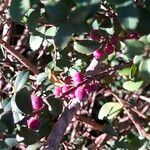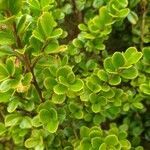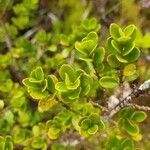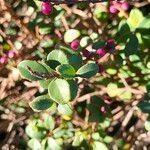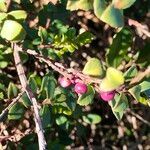Leaves very numerous, crowded, 6–12 mm. long, varying from ± orbicular to elliptic or obovate, acute or obtuse and apiculate at apex, subsessile or tapering at base to a petiole c. 1 mm. long, the proximal part of the midrib on adaxial side tomentose, otherwise lamina glabrous, coriaceous, inconspicuously nerved apart from the prominent abaxial midrib, the margin slightly revolute and sparsely serrulate (teeth usually inconspicuous due to the curved margin).
A shrub or small tree. It can be 3 m high. The bark is reddish. The branches are 0.5-2 mm thick. The leaves are small and sword shaped or round. They are 0.5-2 cm long by 0.5-1 cm wide. They are leathery and glossy green. There can be small teeth along the edge. The flowers are small and pink. The fruit is thinly fleshy and 4 mm across. They are pink when mature.
Female flower: anthers as in male but shorter than and concealed by corolla (flower c. 2 mm. long), functionless; ovary c. 1–2 mm. long, clavate, with prominent much–lobed capitate stigma.
Fruit a globose 1–seeded drupe, at first dry, greenish and c. 2–3 mm. in diameter, later developing a purplish fleshy pericarp and swelling to 8 mm. in diameter.
Male flower: anthers 1·3–2 mm. long, long–exserted from corolla (flower c. 2–2·5 mm. long), oblong–triangular, apiculate, red; ovary vestigial, clavate.
Corolla gamopetalous, with rounded–triangular ciliate lobes ± as long as the tube, greenish, cream–coloured or pink, conspicuously punctate.
Much branched, functionally dioecious perennial varying from a suffrutex 30 cm. high to a large shrub up to 3·5 m. tall.
Calyx c. 1/2 as long as corolla, divided almost to the base, the lobes ovate, ciliate, conspicuously glandular–punctate.
Flowers tetramerous, small, borne in several–flowered axillary fascicles, shortly pedicellate.
Branches ascending, rusty– or brownish–tomentose especially at apices.
Bark smooth to finely rugose, brownish–grey.
